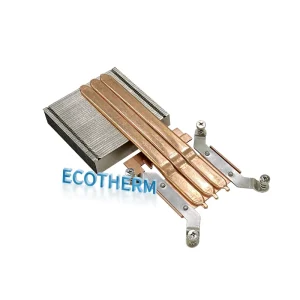Data Center Cooling Solutions for AI, Cloud, and Edge Computing Environments
Data Center Cooling Solutions for AI, Cloud, and Edge Computing Environments
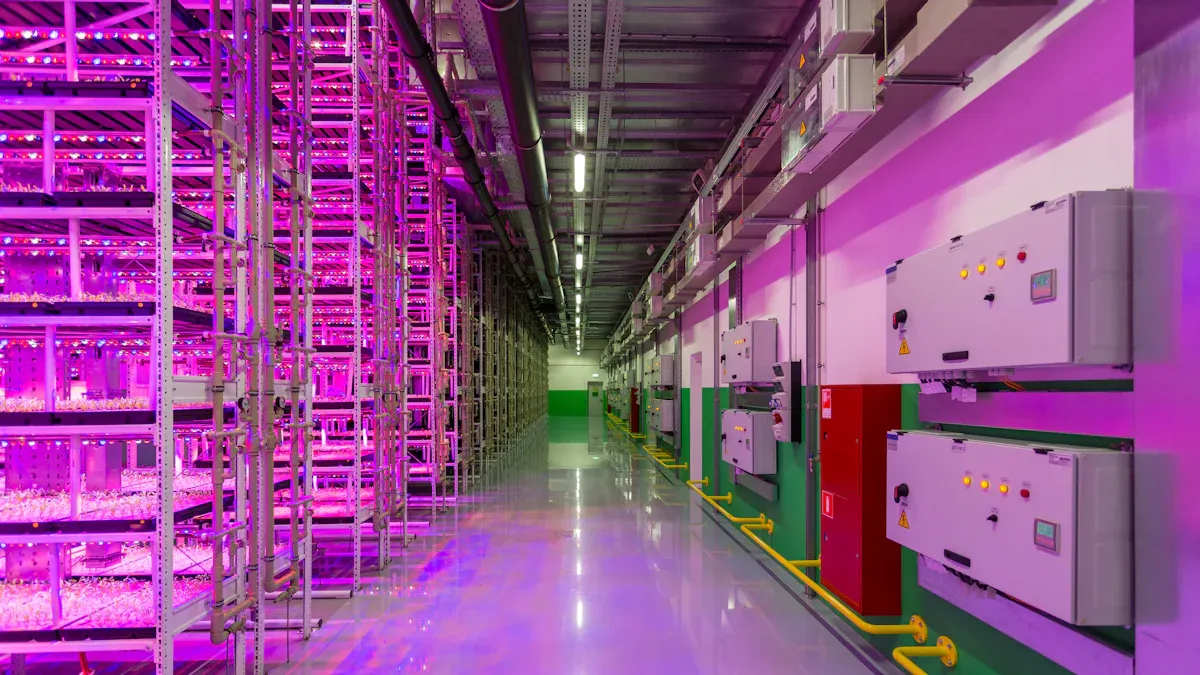
Effective data center cooling keeps high-density servers at safe temperatures, even when workloads push hardware to its limits. You need solutions that adapt quickly and use less energy. Advanced technologies, like liquid cooling, help manage heat and reduce environmental impact.
Energy-efficient cooling strategies lower operational costs and support sustainability goals.
| Metric/Technology | Description |
|---|---|
| Power Usage Effectiveness (PUE) | A key metric that compares total facility energy consumption to the energy used by IT equipment. Lower values indicate better efficiency. |
| Liquid Cooling Solutions | Emerging as a preferred method for high-density workloads, addressing the limitations of traditional air cooling. Only 20% currently use it, but adoption is increasing. |
| Energy-Efficient Cooling Strategies | Reduce reliance on traditional HVAC systems, helping to maintain optimal server temperatures while minimizing energy consumption. |
- Advanced cooling technologies meet the thermal demands of modern data centers.
- Energy-efficient practices cut waste and support green initiatives.
Key Takeaways
- Effective cooling is essential for high-density servers to prevent overheating and ensure reliable performance.
- Liquid cooling is becoming a preferred method for managing heat in modern data centers, offering significant energy savings.
- AI workloads generate high heat loads, requiring advanced cooling solutions that traditional air systems cannot provide.
- Hybrid cooling systems combine air and liquid cooling to optimize efficiency and adapt to changing workloads.
- Containment strategies improve cooling performance by separating hot and cold air, reducing energy waste.
- Modular cooling designs allow for quick scaling and flexibility, making them ideal for growing data centers.
- Investing in energy-efficient cooling technologies can lead to long-term cost savings and support sustainability goals.
- Regular maintenance and monitoring of cooling systems are crucial for maintaining efficiency and preventing equipment failure.
Data Center Cooling Challenges
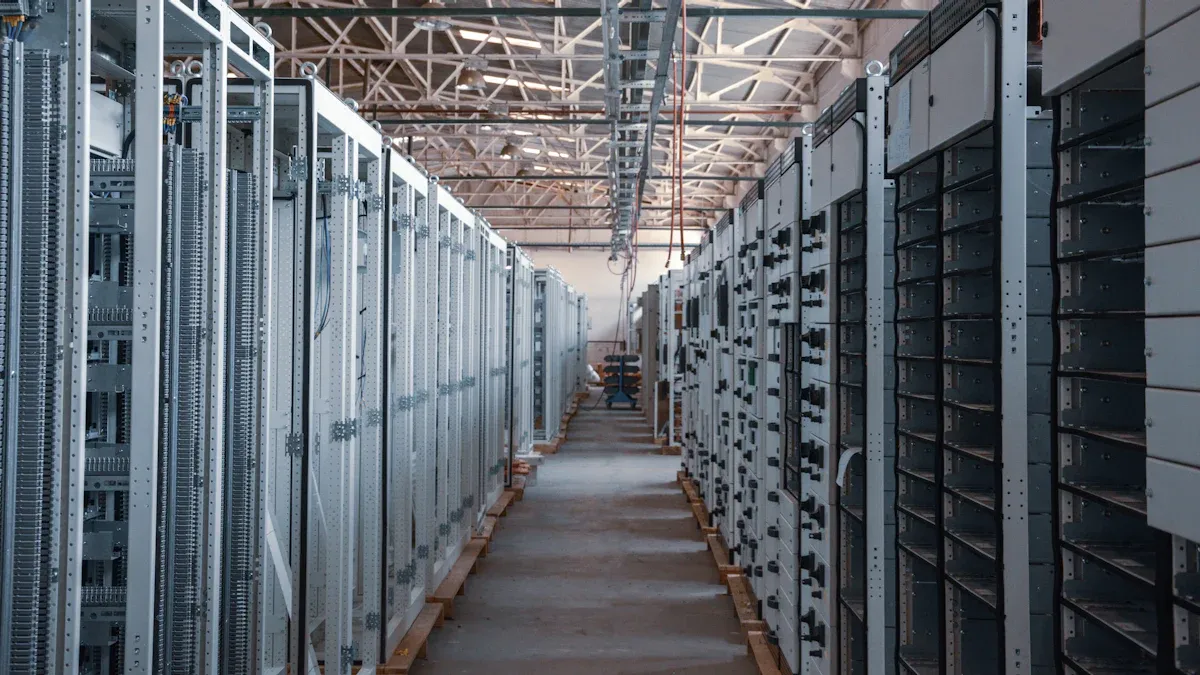
High-Density Demands
You face new challenges as servers become more powerful and compact. High-performance GPUs and CPUs now sit tightly packed in racks, each producing up to 3kW of heat. This can push total rack heat loads to 50 kW or more. In large facilities, the total heat output can reach 30–50 megawatts, which matches the power used by tens of thousands of homes.
- You must manage:
- Increased thermal loads from advanced hardware.
- The physical weight of dense equipment, which affects airflow and cooling design.
- The complexity of cooling systems, especially as you move toward liquid cooling.
AI workloads, in particular, demand much more power than traditional applications. For example, training large AI models uses far more energy than standard IT tasks. Even a single ChatGPT query can use nearly ten times the electricity of a typical web search. As a result, average rack power density is rising from 15 kW to as much as 120 kW per rack in some cases. This shift puts pressure on your cooling systems to keep up.
Traditional Cooling Limits
Traditional air cooling methods struggle to keep pace with these demands. Air conditioning and fans have served data centers for decades, but they now show their limits. As you add more servers and increase power density, air cooling becomes less effective and more expensive.
Traditional air cooling is energy-intensive in high-density environments. It leads to higher operational costs and a larger carbon footprint. The noise from multiple fans and air conditioners also creates an uncomfortable workspace.
You may notice that air cooling cannot target specific hot spots in racks. As a result, some components overheat while others remain cool. This inefficiency wastes energy and increases the risk of hardware failure. The exponential growth in data processing makes these problems worse. You need better solutions to handle the heat.
AI, Cloud, and Edge Needs
AI, cloud, and edge computing introduce unique cooling requirements. AI workloads generate concentrated heat loads because of dense GPU clusters and continuous processing. Cloud data centers must support high-density server arrangements, which create hot spots that traditional cooling cannot manage well. Edge computing adds another layer of complexity. Smaller, distributed data centers often lack the space and infrastructure for large-scale cooling systems.
- Unique requirements include:
- Advanced cooling technologies like liquid cooling for high power densities.
- Precision cooling and modular systems to manage thermal demands.
- Solutions for smaller, distributed edge sites.
AI workloads drive unprecedented power densities in servers and racks. Traditional cooling techniques fail to keep up with the rapid advancements in generative AI, machine learning, and large-scale inferencing.
You must rethink your approach to data center cooling. Modern workloads require solutions that adapt quickly, target specific heat sources, and scale with your needs.
Liquid Cooling
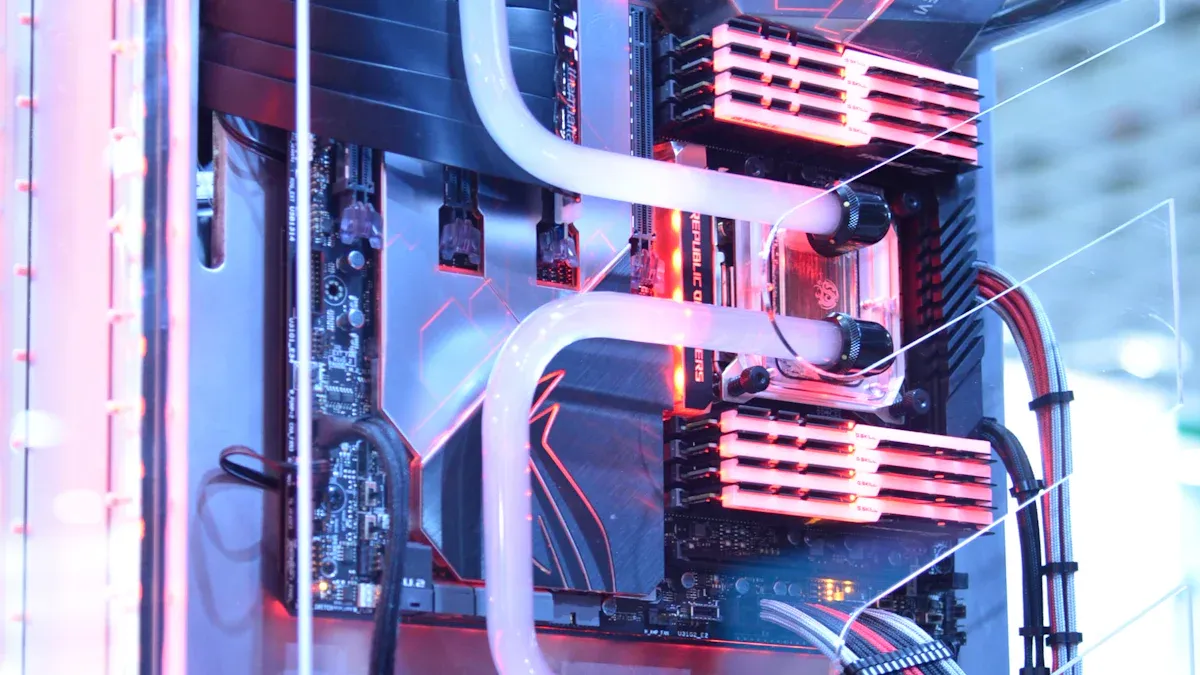
Liquid cooling has become a leading solution for data center cooling, especially as you support AI, cloud, and edge workloads. You can use liquid cooling to manage high-density infrastructure, reduce energy use, and maintain stable temperatures even when servers run at full capacity. Hyperscale data centers lead the way in adopting these systems, but enterprise and edge sites are quickly following. You can see this shift as organizations seek better efficiency and sustainability.
Direct-to-Chip
Direct-to-chip cooling brings coolant right to the hottest parts of your servers. This method targets CPUs, GPUs, and memory modules, which generate the most heat.
Operation
You install cold plates directly on top of chips. Coolant flows through these plates, absorbing heat before it leaves the server. The system uses pipes and pumps to move the coolant to and from the chips. Coolant distribution units (CDUs) manage the flow and temperature, keeping everything balanced.
| Minimum Coolant Temperature | Maximum Coolant Temperature |
|---|---|
| 30℃ | Varies based on heat load |
| 20-24℃ | For high-density chips |
Direct-to-chip systems can operate with coolant temperatures as low as 20-24℃ for high-density chips. Some systems work at higher temperatures, depending on the heat load.
Benefits
You gain several advantages with direct-to-chip cooling:
- You can achieve over 25% greater efficiency than air-based solutions.
- You use up to 25% less power to cool the same server.
- You reduce electricity costs for cooling by up to 89%.
- You lower overall data center electricity costs by up to 40%.
- You cut noise levels by up to 55%, creating a quieter workspace.
Michael McNerney, Senior Vice President at Supermicro, explains that liquid cooling is critical for reducing data center energy use and enabling next-generation CPUs and GPUs to perform as expected.
Direct-to-chip cooling supports high-performance workloads without increasing your energy usage. You can keep your servers running reliably, even as you push them harder.
Immersion
Immersion cooling takes a different approach. You submerge entire servers or components in a special dielectric fluid that does not conduct electricity. This method removes heat directly from all surfaces, not just the chips.
Single-Phase
Single-phase immersion cooling uses a fluid that stays in liquid form. Pumps move the fluid around the tank, carrying heat away from the hardware.
| Aspect | Single-Phase | Two-Phase |
|---|---|---|
| Cooling Efficiency | Moderate to high | Very high |
| Energy Use | Higher (pumps needed) | Lower (often passive) |
| Heat Load Capacity | Moderate | High |
| System Complexity | Simpler | More complex |
Single-phase systems have lower installation costs because they use simple designs and widely available fluids. Maintenance is straightforward, and you can access components easily. However, operational costs are higher due to pump energy and fluid filtration. These systems can save you 20-30% on cooling energy costs compared to air cooling.
Two-Phase
Two-phase immersion cooling uses a fluid that boils when it absorbs heat. The fluid changes from liquid to vapor, carrying heat away more efficiently. The vapor then condenses back into liquid, releasing the heat to a cooling coil.
Two-phase systems offer very high cooling efficiency and can reduce cooling energy costs by up to 40% compared to air cooling. These systems often work passively, so you use less energy. Installation costs are higher because you need specialized tanks and fluids. Maintenance is more complex and requires special training, but operational costs are lower.
Two-phase systems handle higher heat loads and provide better energy savings, but you must weigh the complexity and cost against your needs.
Cold Plates & CDUs
Cold plates and coolant distribution units (CDUs) form the backbone of many liquid cooling setups. You attach cold plates to the hottest components, and CDUs manage the flow and temperature of the coolant throughout your data center.
Coolant distribution units serve as the vital core of liquid-cooled data centers, functioning as the beating heart that sustains optimal operating conditions. These units play a critical role in effectively managing the distribution of coolant throughout the intricate network of servers and equipment, ensuring efficient heat dissipation and maintaining stable temperatures within the facility.
Liquid cooling offers superior thermal management by directly absorbing and dissipating heat more efficiently from the hottest components, preventing overheating and ensuring continuous, reliable operation.
You can place CDUs in racks or rows, depending on your layout. This flexibility lets you scale your data center cooling as your needs grow. Experiments show that using advanced control strategies with CDUs can save up to 87% in pumping power when racks are idle. Because liquid is more effective than air at transferring heat, CDUs help you support higher rack densities that would overwhelm traditional air-cooled systems.
Liquid is more efficient than air at transferring heat, so you can introduce CDUs where higher rack densities have increased the heat beyond the capability of air-cooled systems.
Liquid cooling stands out as a future-ready solution for data center cooling. You can support AI, cloud, and edge workloads while reducing energy use and maintaining reliable performance.
Hybrid Cooling Approaches
Hybrid cooling approaches combine different technologies to help you manage heat in modern data centers. You can use these systems to balance efficiency, flexibility, and cost. Hybrid solutions often mix air and liquid cooling, containment strategies, and targeted cooling units. These methods help you adapt to changing workloads and higher rack densities.
Air-Liquid Systems
Air-liquid systems blend traditional air cooling with advanced liquid cooling. You use air to cool less demanding equipment and liquid for high-performance servers. This approach lets you target the hottest components while keeping overall energy use low.
| Cooling System Type | Annual Average EER | PUE Values (Regions) |
|---|---|---|
| Liquid-Pump-Driven Free Cooling | 7.07–14.18 | < 1.40 (most regions) |
| Hybrid System | 4.22–14.10 | < 1.40 (most regions) |
You can see that hybrid systems help you achieve low PUE values, which means better energy efficiency. Cooling systems use about 40% of a data center’s total energy. Lowering cooling energy use is key to improving your overall efficiency. When you introduce liquid cooling into an air-cooled setup, you may need to look beyond PUE and consider other metrics like TUE for a complete picture.
Hybrid cooling systems let you scale your infrastructure and support both legacy and new hardware. You can upgrade your cooling without replacing everything at once.
Containment
Containment strategies help you control airflow and separate hot and cold air streams. You can use hot aisle containment (HAC) or cold aisle containment (CAC) to keep hot exhaust air from mixing with cool intake air. This separation keeps inlet temperatures steady and improves cooling performance.
Containment works well for mixed workloads. You can stabilize airflow and prevent recirculation, which helps your cooling systems run more efficiently. When you use containment, you make sure that every server gets the right amount of cool air.
Containment systems create a predictable environment for your cooling equipment. You reduce energy waste and lower the risk of overheating.
In-Row & Overhead
In-row and overhead cooling systems place cooling units close to the heat source. You install these units between server racks or above them. This setup lets you target hot spots directly and maintain even cooling across all equipment.
- In-row cooling addresses heat from server racks more effectively than perimeter systems.
- These systems work well in high-density environments, especially for edge computing sites with limited space.
- Studies show that in-row cooling can save you up to 25% in energy costs compared to traditional perimeter units.
A study found that in-row cooling keeps temperatures uniform along the height of server racks. This is important for high-density setups. In-row systems also handle increased power density better than older cooling methods.
You can use in-row and overhead cooling to support edge deployments and scale your data center cooling as your needs grow.
Hybrid cooling approaches give you the flexibility to meet the demands of AI, cloud, and edge workloads. You can combine different methods to optimize efficiency and prepare for future growth.
Data Center Cooling Selection
Heat Load & Density
When you select a cooling solution, you must first look at your heat load and equipment density. High-performance servers and GPUs generate more heat in a smaller space. This makes it important to match your cooling system to your actual needs. You can use the following table to guide your evaluation:
| Factor | Metric | Considerations |
|---|---|---|
| Heat Load | Power density (watts per square foot or kW per rack) | IT power consumption, desired temperature range, future growth and heat changes |
| Energy Efficiency | COP, PUE | Cooling system efficiency, energy-saving strategies (free cooling, variable speed drives) |
| IT Equipment Requirements | Power density, operating temperature, airflow | Cooling needs of specific hardware (HPC servers, GPUs), airflow patterns (front-to-back, etc.) |
| Scalability & Future Growth | Modular design, flexibility | Ability to handle high heat loads, increased densities, and changes in technology or business |
You should measure your current power density and estimate how it might change as you add more equipment. Some racks may reach 50 kW or more, especially with AI workloads. You also need to check the airflow requirements for your hardware. Not all servers cool the same way. Some need front-to-back airflow, while others use side-to-side. Matching your cooling system to these needs helps prevent hot spots and keeps your equipment safe.
Tip: Always plan for future growth. If you expect to add more high-density servers, choose a cooling system that can scale up without major changes.
Scalability
Scalability is a key factor when you choose a cooling solution. You want a system that grows with your needs. AI and cloud computing workloads can increase quickly, so your cooling must keep up. Here are some ways modern cooling solutions support scalability:
- Purpose-built systems support demanding AI and machine learning workloads.
- Optimized environments allow for high-density compute and low-latency connections.
- Rapid provisioning is possible with pre-negotiated utility contracts.
- Microfluidics cooling manages heat in AI chips efficiently, allowing higher performance and density.
- This technology enables denser server packing, which increases compute capacity without needing more space.
You can also look at advanced cooling systems that support up to 125kW per rack. These systems often include redundant power for reliability and allow vertical growth. This means you can add more servers without expanding your data center’s footprint.
- Advanced cooling systems, including liquid cooling, support high-density workloads.
- Redundant power ensures continuous operation.
- Modular designs allow you to scale vertically and adapt to new technology trends.
Note: Choose a cooling solution that adapts to both current and future needs. Modular and flexible systems help you avoid costly upgrades later.
Cost & ROI
Cost and return on investment (ROI) play a big role in your decision. Advanced cooling technologies, such as liquid cooling, can cost more to install. However, they often save you money over time. These systems improve energy efficiency and reduce operational costs. As your data center grows, maintaining optimal temperatures becomes more complex. Investing in efficient cooling now can lead to significant savings in the future.
You should compare the upfront costs with the long-term benefits. Liquid cooling systems, for example, offer better performance and lower energy bills. This makes them a smart choice for high-density environments. The ROI from advanced cooling is now a crucial metric in the industry. You want to see not just lower energy use, but also improved reliability and fewer hardware failures.
Remember: The right cooling solution balances initial investment with long-term savings and performance gains.
Sustainability
You play a key role in making your data center more sustainable. Today, you face growing pressure to reduce your carbon footprint and use less energy. When you select a cooling solution, you must think about its impact on the environment as well as its performance.
Sustainable data center cooling focuses on three main goals:
Lowering Energy Consumption
You can choose cooling systems that use less electricity. Liquid cooling and hybrid systems often require less energy than traditional air conditioning. These systems help you cut operational costs and reduce greenhouse gas emissions.Using Renewable Energy
Many data centers now run on solar, wind, or hydroelectric power. You can pair efficient cooling with renewable energy to make your facility even greener. Some cooling systems also support free cooling, which uses outside air or water to chill equipment without extra energy.Reducing Water Usage
Some cooling methods, like evaporative cooling, use a lot of water. You should look for solutions that recycle water or use closed-loop systems. These options help you save water and meet local regulations.
Tip: Always check the environmental certifications of your cooling equipment. Look for ENERGY STAR, LEED, or other green labels.
| Sustainability Factor | What You Can Do | Example Solution |
|---|---|---|
| Energy Efficiency | Choose high-efficiency cooling systems | Liquid cooling, in-row cooling |
| Water Conservation | Use closed-loop or waterless systems | Direct-to-chip, air cooling |
| Renewable Energy | Power cooling with green electricity | Solar-powered chillers |
| Waste Reduction | Recycle or reuse cooling fluids | Biodegradable coolants |
You should also consider the full lifecycle of your cooling system. Ask yourself these questions:
- How long will the equipment last?
- Can you recycle or safely dispose of the materials?
- Does the system use chemicals that harm the environment?
By making smart choices, you help your company meet sustainability goals and comply with global standards. You also build a reputation for environmental responsibility, which can attract customers and partners.
Remember: Sustainable cooling is not just about saving energy. It is about protecting resources for the future.
Implementation Issues
Retrofitting
When you upgrade your data center with new cooling technologies, you face several challenges. Retrofitting existing spaces often means working around old layouts and equipment. You need to plan carefully to avoid disruptions and ensure compatibility.
- Airflow management becomes tricky when you add new cooling units.
- You may struggle to implement aisle containment strategies in older setups.
- Compatibility issues can arise between new and existing cooling systems.
- Adding in-row coolers sometimes requires you to rearrange cabinets.
- Installing new fire protection heads during retrofits can cause temporary disruptions.
Tip: Always assess your current infrastructure before starting a retrofit. This helps you identify potential obstacles and plan for a smoother transition.
Maintenance
You must consider how maintenance needs change with different cooling systems. Traditional air cooling systems are usually simpler and require less attention. Advanced liquid cooling systems, however, involve more complex components and need regular checks.
| Cooling System Type | Maintenance Requirements |
|---|---|
| Traditional Air Cooling | Generally lower, simpler with fewer components. |
| Advanced Liquid Cooling | Requires occasional attention, more complex installation. |
With liquid cooling, you need to monitor coolant quality, check for leaks, and maintain pumps and distribution units. These tasks help prevent downtime and keep your servers running efficiently. Air cooling systems mostly need filter changes and fan inspections, which are easier and less time-consuming.
Regular maintenance keeps your cooling systems efficient and extends the life of your equipment.
Monitoring
You need reliable monitoring to ensure your cooling systems work at their best. Modern data centers use advanced sensor technologies to track temperature, humidity, and airflow. Real-time monitoring systems let you spot problems early and take action before they cause damage.
- 3D TRASAR Technology for Direct-to-Chip Liquid Cooling gives you data and recommended actions.
- 3D TRASAR for Cooling Water improves cooling tower and chiller efficiency while saving water.
- 3D TRASAR for Adiabatic Cooling monitors water quality in evaporative systems.
- Ecolab® Water Track IQ™ provides real-time visibility into water usage and highlights savings opportunities.
You can also use integrated cooling management solutions to optimize cooling capacity and reduce the risk of equipment failure. Technologies like IO-Link make it easier to connect smart sensors, which improves system flexibility. Monitoring coolant quality in real time helps you schedule maintenance only when needed, saving time and resources.
Smart monitoring not only protects your equipment but also helps you save energy and reduce costs. With the right tools, you can keep your data center cool, efficient, and ready for future demands.
Trends & Best Practices
Modular Design
You see modular cooling systems changing how data centers grow and adapt. Modular data centers use prefabricated designs, which let you deploy new capacity quickly. You can add modules as your needs increase, so you avoid large upfront costs. This approach gives you agility and flexibility, especially when you support cloud computing and AI workloads.
- You can scale your data center almost instantly by adding new modules.
- You minimize downtime, which helps your business stay productive.
- You find modular cooling ideal for remote locations where building a traditional data center is hard.
Immersion cooling is also becoming popular in modular setups. You can reduce energy use by up to 30% with immersion cooling. This method supports sustainability goals and helps you reuse waste heat. Many modular systems now integrate liquid cooling and free air cooling, which lower energy consumption. You can also use renewable energy sources, such as solar panels and wind turbines, to make your cooling even greener.
- Modular cooling supports rapid deployment.
- You gain flexibility for future growth.
- You help your company meet sustainability targets.
Modular design lets you respond quickly to changing demands. You avoid overbuilding and save money by scaling only when needed.
AI Optimization
You can use artificial intelligence to make your cooling systems smarter and more efficient. AI collects data from sensors that measure temperature, humidity, and airflow. It adjusts cooling in real time, so you prevent hotspots and save energy.
- Machine learning algorithms forecast thermal buildup and make proactive changes.
- AI systems enhance airflow only where needed, which reduces wear on fans and other parts.
- You can activate free cooling when outside air is cool enough, lowering the workload on chillers.
Digital Twins help you test cooling strategies before you make changes. You create a virtual model of your data center, which lets you see how heat moves and how airflow behaves. You optimize your cooling without risking downtime.
Major companies use AI to cut costs and improve efficiency. Google’s DeepMind reduced cooling energy use by 40%. Meta lowered fan energy consumption by 20%. NTT America saved $630,000 each year with AI-driven cooling.
AI helps you run your data center more efficiently. You save money and support sustainability.
Future Tech
You will see new technologies shaping the future of data center cooling. Direct-to-chip cooling sends coolant straight to CPUs and GPUs, which maximizes efficiency and prevents overheating. Immersion cooling submerges servers in special liquids, making it effective for high-density environments. Liquid cooling systems keep temperatures lower than air cooling, which extends hardware life and reduces energy use.
| Cooling Method | Description | Advantages |
|---|---|---|
| Direct-to-chip cooling | Circulates coolant directly to heat-generating components like CPUs and GPUs. | Maximizes cooling efficiency and minimizes overheating risks. |
| Immersion cooling | Servers are submerged in a non-conductive liquid that absorbs heat. | Effective for high-density environments; supports sustainability goals. |
| Liquid cooling systems | Maintains lower temperatures than air cooling. | Reduces energy consumption and extends hardware lifespan. |
You can expect these technologies to become more common as AI and edge computing grow. You will need cooling solutions that handle higher heat loads and support sustainability.
Future-ready cooling helps you keep up with new workloads and environmental standards.
You have many options for data center cooling, from advanced liquid systems to modular air solutions. The table below highlights leading providers and their technologies:
| Company | Score | Key Technologies and Features | Target Audience |
|---|---|---|---|
| Johnson Controls | 79.8 | YORK chillers, Silent-Aire hyperscale cooling, OpenBlue software | Operators seeking mature, scalable solutions for multi-site operations with a focus on energy efficiency and lifecycle value |
| Schneider Electric | 74.1 | EcoStruxure + DCIM 3.0, Motivair acquisition, modular builds | Enterprises or edge facilities prioritizing flexible deployment, global support, and AI-readiness |
| Daikin | 73.3 | CRAH units, AHRI-standard chillers, Daikin on Site monitoring | Data centers favoring standard-compliant air cooling with strong monitoring and circular economy capabilities |
| Trane | 71.1 | TRACE®, myPLV®, myCO2e™ software tools, LiquidStack immersion cooling | Facility managers and engineers focused on simulation-led design, performance optimization, and circular maintenance |
| Danfoss | 68.3 | End-to-end cooling incl. direct-to-chip, Leanheat software, heat reuse | Operators seeking liquid cooling innovations, heat reuse, and small-footprint efficiency |
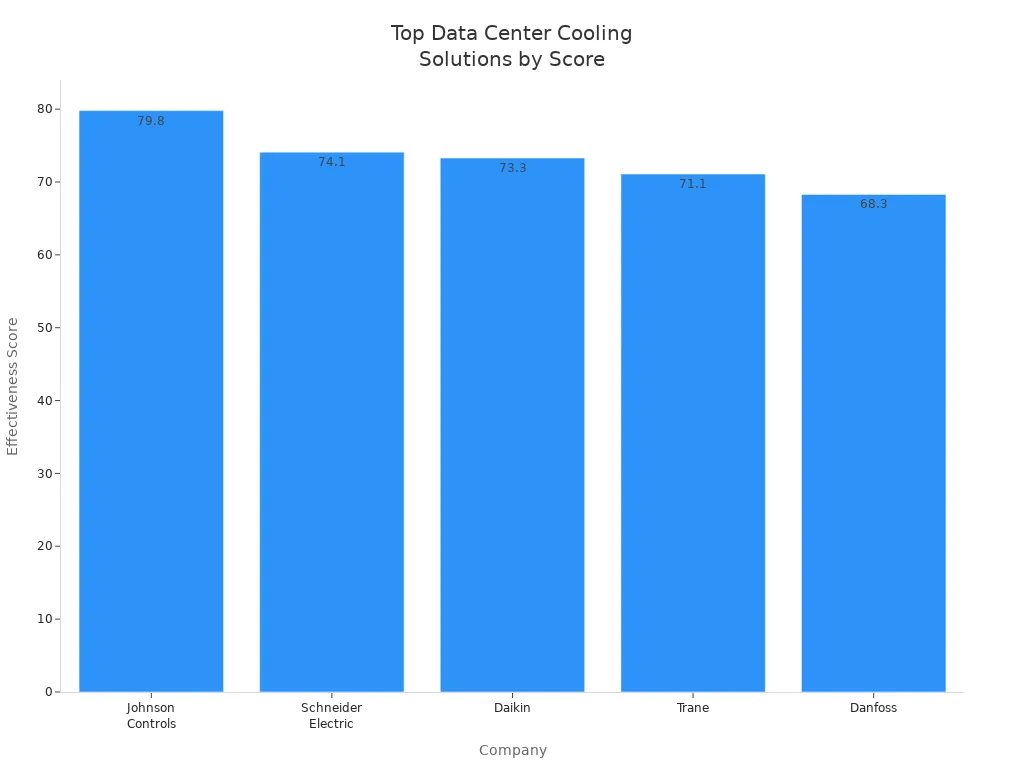
To align your cooling choices with sustainability and scalability, focus on energy-efficient designs, flexible systems, and ongoing evaluation of best practices like airflow management and containment.
While you cannot fully future-proof your facility, planning for adaptability helps you avoid outdated investments.
FAQ
What is the most energy-efficient cooling method for high-density data centers?
Liquid cooling stands out as the most energy-efficient option. You can remove heat directly from servers, which lowers energy use. This method works well for AI and cloud workloads that generate intense heat.
Can you retrofit liquid cooling into an existing data center?
Yes, you can retrofit liquid cooling. You may need to adjust rack layouts and add new piping. Careful planning helps you avoid downtime. Many vendors offer modular solutions for easier upgrades.
How does AI help optimize data center cooling?
AI analyzes sensor data to adjust cooling in real time. You can prevent hot spots and reduce wasted energy. Machine learning predicts temperature changes, so your system stays efficient.
What are the main benefits of containment systems?
Containment systems separate hot and cold air. You keep server temperatures stable and improve cooling efficiency. This setup reduces energy waste and lowers the risk of overheating.
Is immersion cooling safe for sensitive IT equipment?
Immersion cooling uses special non-conductive fluids. You can safely submerge servers without damaging electronics. This method protects hardware and supports high-density deployments.
How do you measure cooling efficiency in a data center?
You use Power Usage Effectiveness (PUE) to measure efficiency. Lower PUE values mean better performance. You can also track metrics like Cooling System Coefficient of Performance (COP) for deeper insights.
What cooling solutions work best for edge data centers?
Edge data centers often use modular and in-row cooling. You can deploy these systems quickly in small spaces. Liquid cooling also works well for high-density edge sites.
Does sustainable cooling cost more to install?
Sustainable cooling may cost more upfront. You save money over time through lower energy bills and reduced maintenance. Many companies see a strong return on investment.

